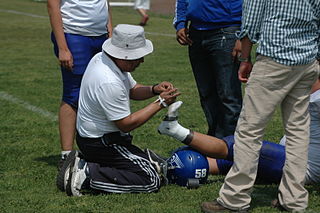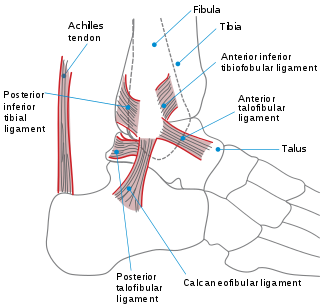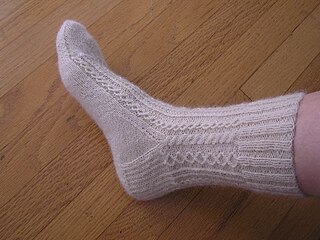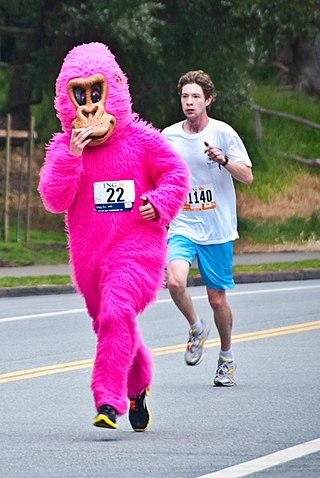Related Research Articles

Sports injuries are injuries that occur during sports or exercise in general. In the United States, approximately 30 million people participate in some form of organized sports. Of those 30 million, about 3 million athletes aged 14 and under suffer a sports related injury annually. According to a study performed at Stanford University, 21% of injuries observed in elite college athletes caused them to miss at least one day of sports activity, and approximately 77% of these injuries involved the knee, leg, ankle, or foot. The leading cause of death from sports injuries is traumatic head or neck injuries.

Softball is a popular variation of baseball, the difference being that it is played with a larger ball, on a smaller field, and with only underhand pitches permitted. Softball is played competitively at club levels, the college level, and the professional level. The game was first created in 1887 in Chicago by George Hancock.
A sprain is a soft tissue injury of the ligaments within a joint, often caused by a sudden movement abruptly forcing the joint to exceed its functional range of motion. Ligaments are tough, inelastic fibers made of collagen that connect two or more bones to form a joint and are important for joint stability and proprioception, which is the body's sense of limb position and movement. Sprains may be mild, moderate, or severe, with the latter two classes involving some degree of tearing of the ligament. Sprains can occur at any joint but most commonly occur in the ankle, knee, or wrist. An equivalent injury to a muscle or tendon is known as a strain.

Podiatry, or podiatric medicine and surgery, is a branch of medicine devoted to the study, diagnosis, and treatment of disorders of the foot, ankle and lower limb. The healthcare professional is known as a podiatrist. The US podiatric medical school curriculum includes lower extremity anatomy, general human anatomy, physiology, general medicine, physical assessment, biochemistry, neurobiology, pathophysiology, genetics and embryology, microbiology, histology, pharmacology, women's health, physical rehabilitation, sports medicine, research, ethics and jurisprudence, biomechanics, general principles of orthopedic surgery, plastic surgery, and foot and ankle surgery.

The London Museum Docklands, based in West India Quay, explains the history of the River Thames, the growth of Port of London and the docks' historical link to the Atlantic slave trade. The museum is part of the Museum of London and is jointly funded by the City of London Corporation and the Greater London Authority.

Paul Albert Attanasio is an American screenwriter and film and television producer. He has twice been nominated for the Academy Award for Best Adapted Screenplay, for Quiz Show (1994) and Donnie Brasco (1997).

Breakdancing or breaking, also called b-boying or b-girling (women), is a style of street dance originated by African Americans and Puerto Ricans in the Bronx borough of New York City.
A leglock is a joint lock that is directed at joints of the leg such as the ankle, knee or hip joint. A leglock which is directed at joints in the foot is sometimes referred to as a foot lock and a lock at the hip as a hip lock. Leglocks are featured, with various levels of restrictions, in combat sports and martial arts such as Sambo, Brazilian Jiu-Jitsu, catch wrestling, mixed martial arts, Shootwrestling and submission wrestling, but are banned in some sports featuring joint locks such as judo. The technique has been seen across a wide range of different combat sports and is reportedly over 2,500 years old, having been seen in the lost art of Pankration in the original Olympic Games.

A sprained ankle is an injury where sprain occurs on one or more ligaments of the ankle. It is the most commonly occurring injury in sports, mainly in ball sports such as basketball, volleyball, football, pickleball, and tennis.

Herbert Art Gallery & Museum is a museum, art gallery, records archive, learning centre, media studio and creative arts facility on Jordan Well, Coventry, England.

A pin, or fall, is a victory condition in various forms of wrestling that is met by holding an opponent's shoulders or scapulae on the wrestling mat for a prescribed period of time. This article deals with the pin as it is defined in amateur wrestling.

The Orange County Breakers are a World TeamTennis (WTT) franchise founded in 2003, owned by Laguna Beach businessman Eric Davidson. The Breakers won the WTT Championship in 2004, 2017 and 2021. In 2014, the franchise moved to Greater Austin, Texas, where it was known as the Austin Aces. On December 14, 2015, the Aces announced that the team would move back to Orange County, California for the 2016 season and be renamed the Orange County Breakers. In 2016, the Breakers played their home matches at Breakers Stadium at the Newport Beach Tennis Club. In 2017, the Breakers returned to playing at the Palisades Tennis Club, the venue where they played from 2003 to 2006.

A sock is a piece of clothing worn on the feet and often covering the ankle or some part of the calf. Some types of shoes or boots are typically worn over socks. In ancient times, socks were made from leather or matted animal hair. In the late 16th century, machine-knit socks were first produced. Until the 1800s, both hand-made and machine-knit socks were manufactured, with the latter technique becoming more common in the 19th century, and continuing until the modern day.
Thomas Iain Abercrombie is a New Zealand former professional basketball player who played 16 seasons in the Australian National Basketball League (NBL) for the New Zealand Breakers. A product of Westlake Boys High School in Auckland, Abercrombie had a short-lived college basketball stint with Washington State before debuting in the Australian NBL in 2008 with the Breakers. In 2011, he won his first NBL championship and earned Grand Final MVP honours. He went on to win three more championships in 2012, 2013 and 2015. He ended his NBL career in 2024 as the Breakers' most-capped player with 429 games.

Corey Webster is a New Zealand professional basketball player who last played for the Auckland Tuatara of the New Zealand National Basketball League (NZNBL). He joined the New Zealand Breakers of the Australian National Basketball League (NBL) for the first time in 2008 after a season of college basketball in the United States for Lambuth University, and won championships with the club in 2011, 2013 and 2015.

The Engineering Heritage Awards, formally known as the Engineering Heritage Hallmark Scheme, were established by the Institution of Mechanical Engineers (IMechE) in 1984 to identify and promote artefacts, locations, collections and landmarks of significant engineering importance.

Bay to Breakers is an annual footrace in San Francisco, California typically on the third Sunday of May. The phrase "Bay to Breakers" reflects the fact that the race starts at the northeast end of the downtown area a few blocks from The Embarcadero and runs west through the city to finish at the Great Highway. The complete course is 7.46 miles (12 km) long.
Tai William Evans Wesley is an American professional basketball player. He played college basketball for the Utah State Aggies, where he was named the Western Athletic Conference Player of the Year in 2011. After beginning his career with successful stints in Europe, he made a name for himself in Australia and New Zealand, winning two Australian NBL championships and three New Zealand NBL championships. Wesley also represented the Guam national team on numerous occasions.
Shea Ili is a New Zealand professional basketball player for Melbourne United of the Australian National Basketball League (NBL). He is also contracted with the Sandringham Sabres of the NBL1 South. He debuted in the Australian NBL in 2014 with the New Zealand Breakers. He was a member of the Breakers' championship-winning team in 2015 and in 2018 he named the NBL Most Improved Player. He joined United in 2019 and in 2021 he won his second NBL championship. He was named NBL Best Sixth Man in 2022 and NBL Best Defensive Player in 2024.
The Rizal Golden Coolers, also known as the Rizal Xentromall Golden Coolers for sponsorship reasons, are a Filipino professional basketball team based in Antipolo, Rizal. The team competes in the Maharlika Pilipinas Basketball League (MPBL) as a member of the league's North Division. They are one of five teams based in the Calabarzon region and play their home games at the Ynares Center.
References
- ↑ "Defences | Lunt Roman Fort". luntromanfort.org. Retrieved 2017-01-31.
- ↑ "Archaeologists reveal more about Roman marching camp found at sports stadium excavation in York | Culture24". culture24.org.uk. Retrieved 2017-01-31.
- ↑ Attanasio, A. A.; Bigman, Jeff (2011-05-29). The Dragon and the Unicorn: The Perilous Order of Camelot, Volume One. A. A. Attanasio. ISBN 9780983608431.